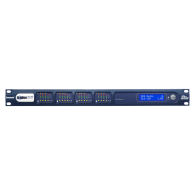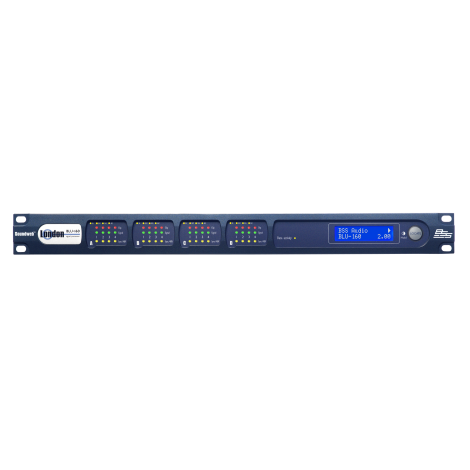Products
"When RaceTech audio systems engineer Robin Dibble undertook the sound system fit-out in the old Queens Stand at the famous Epsom Downs Racecourse eight years ago, he used BSS Audio’s then state-of-the-art Soundweb 9088 ‘Green’ boxes to construct his network. But the world of digital transport moves even faster than the pack on Derby Day, and when Jockey Club Racecourses recently commissioned a £38m three-year development project, including theconstruction of the new 11,000 capacity Duchess Grandstand, he knew that with today’s technology he could adopt vastly more progressive system architecture.
Several generations on, Robin Dibble was able to specify five BSS Audio Soundweb BLU-160 DSPs — placed on the new fault-tolerant BLU-link 256-channel ring. Based on Gigabit Ethernet cabling, the BLU-link equipped Soundweb units are situated in a dedicated air-conditioned control room that houses four 48U racks. A 1U spacer between each of the five BLU-160’s allows each unit to be kept cool, which underpins the reliability of the system, Dibble notes.
The new grandstand was formally opened by the Duchess of Cornwall on April 22 this year, and since the sport of kings only takes place at the course on 14 days of the year, the facility needed to encompass full banqueting, conferencing, exhibition and dining facilities to create a vibrant third-party revenue stream. The heart of the new facilities is the multipurpose Oaks Hal (a satellite betting room only coming into play on race day, when the main space is filled with punters). To make this facility fully-adaptable, and with cutting-edge technology, a highly-specified audio-visual infrastructure and flexible digital backbone was required.
RaceTech have artfully programmed the Soundweb gain and delay structure, such that from most positions within the Oaks Hall the audio image is strongly located at the stage end of the room. “The impression is that the delay loudspeakers within the room are not even on, although coverage down the length of this reverberant room is extremely even, achieving excellent speech intelligibility despite the acoustic environment,” Dibble explained. “The main centre section of the Oaks Hall is configured in stereo with mono side fills. Two pairs of stereo inputs are available to the system from the hall, allowing outside technical facility providers to benefit from this room optimised system.
“Robin Dibble is delighted with the outcome of the integration. “For large scale events clients have to bring nothing other than their own video sources, PC’s and playback devices. We offer IR assisted listening and break-out boxes for local plug-in, with multi-way tie lines which come up to the control position. If any clients want to do anything out of the ordinary we can remotely connect into the Soundweb network and make any necessary changes.”
And with upstairs meeting rooms, with names like the Diomed, Lammtarra & Gallops Rooms enjoying high usage, and feeds from Sky and Terrestrial TV, DVD, PC, tuner and CD all coming into the system, along with commentators, judges and Raceday Radio — all at line level — the full 40 I/O capacity is in use.
In addition to acting as a 40 x 40 routing matrix — delivering any source input to any destination in the building with full audio processing — the safety features range from full redundancy (with UPS back-up), priority/ducking protocols and three paging mic inputs. “And in the event that one BLU-160 should fail I can simply rejig the channel assignments via remote network access as all are configured identically.” Plus of course the system is able to tie in with the old ‘Green’ system still residing in the Queen’s Stand.
Dibble’s design team have ensured that all inputs to the system from all areas are fully balanced at source. This includes all domestic level interfaces around the building. “It’s not allowed near the patchbay until it is balanced!” he says.”The arrival of BLU-link has made bundling so much easier and cost-effective. With 256 channels at our disposal I have been able to make all system inputs and outputs available in any of the five units, vastly increasing the flexibility of the system without having to resort to rewiring the rack every time a configuration changes,” he says. “It’s a very inexpensive way of grouping everything together and although it is a proprietary protocol, CobraNet modules can be specified within the units where compatibility with other CN-equipped devices is necessary.”
The five BLU-160s were not the only products acquired from Harman Pro distributors, Sound Technology. While the system is powered by multiples of Crown CTs 4200s, 1200s and 600s, Robin Dibble has specified three AKG D542ST-S dynamic cardioid gooseneck mics for general public address and communications use. The entire system is under master AMX control with three 12in programmed Modero touch pad giving site wide access from three different locations, and 7″ touch screens in all function room. “We used the Crowns because they are cost-effective, they sound good and they run cool. Also they are electrically efficient so we can have a smaller UPS.”
In summary, he says, “The BLU’s have made a huge difference to the efficiency and have enabled us to deliver a very user-friendly system. BLU-Link offers greater digital capacity and all the processing simply floats in the middle of the BLU-link network.”Fifteen years ago this would have required huge amounts of cable and external processors, patch leads and so on. Now everything is contained within the Soundweb Processors and with a great deal more flexibility.”"




